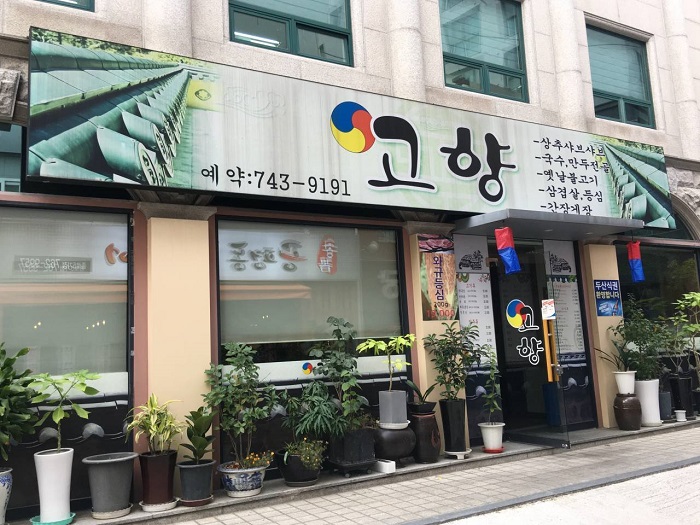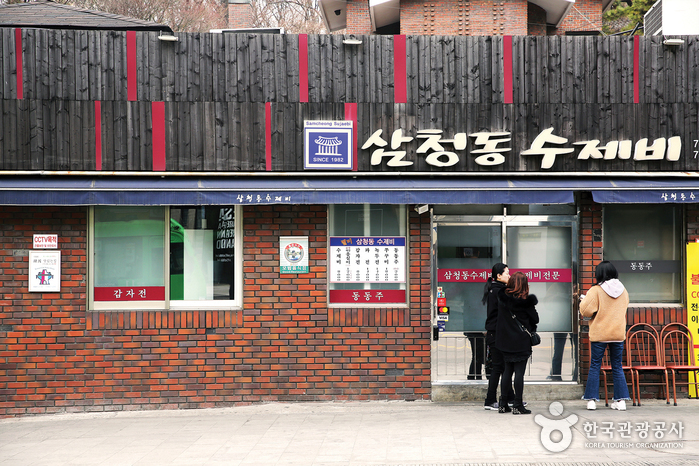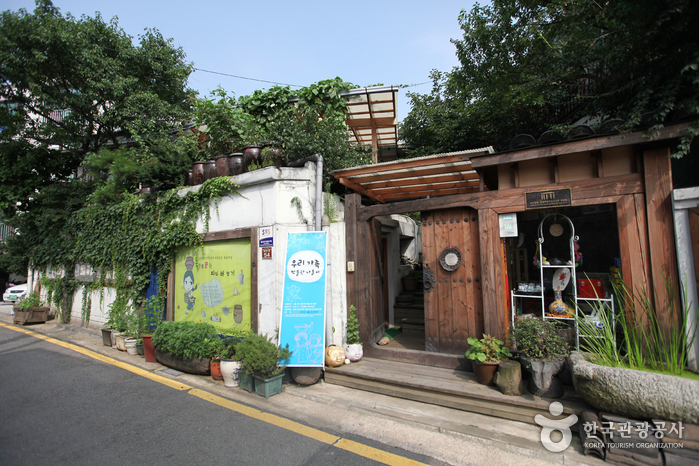Ramada Hotel Dongdaemun (라마다호텔 동대문)
2.6Km 2021-06-15
354, Dongho-ro, Jung-gu, Seoul
+82-2-2276-3500
Ramada Hotel Dongdaemun is a business hotel located in the heart of Seoul. It is located within a short walking distance from Dongdaemun History & Culture Park with many of Dongdaemun's major shopping centers close by. The hotel offers a conference room that can accommodate up to 20 people and a business center that caters to guests who are on a business trip. Guests can also take advantage of free Wi-Fi from their room.
Gohyang (고향)
2.6Km 2021-03-22
15, Jong-ro, 31ga-gil, Jongno-gu, Seoul
+82-2-743-9191
A place where you can try various Korean dishes. This Korean dishes restaurant is located in Jongno-gu, Seoul. The most famous menu is bulgogi.
Samcheongdong Sujebi (삼청동수제비)
2.6Km 2019-06-13
101-1, Samcheong-ro, Jongno-gu, Seoul
+82-2-735-2965
Get off the subway at Gyeongbokgung Station (Subway Line 3), follow the wall of the Gyeongbokgung Palace and you'll find yourself facing a street with majestic trees whose foliage changes every season. This street leads directly to Samcheong-dong. As you enter Samcheong-dong and walk towards the Samchong-dong Tunnel, you'll come across Samcheongdong Sujebi, located right next to the Prime Minister Legation.
Samcheongdong Sujebi became a hit among Japanese tourists, after being featured in a popular Japanese magazine. The main dish here is, of course, sujebi (a traditional Korean soup consisting of chunks of dough and various vegetables). It comes in a pot full of sliced pumpkin, clams, and potatoes. This delicious soup is so tasty that there's almost always people lined up outside the restaurant. Other popular items include dongdongju (traditional Korean liquor) and gamjajeon (a Korean potato pancake that uses only potato starch and no other ingredients).
PEYO (뻬요)
2.6Km 2016-09-05
14 Ehwayeodae 5-gil, Seodaemun-gu, Seoul
02-312-8535
Ce petit café propose des macarons traditionnels du Pays Basque selon une recette familiale. Les macarons ne sont pas preparés à l’aide de farine ou de beurre, mais à base de poudre d’amande. Ouvert tous les jours sauf le dimanche, la boutique propose plusieurs saveurs : originale, chocolat, myrtille, thé vert, canelle et bien d’autres.
CJ Food World (CJ 푸드월드)
2.6Km 2017-11-24
330, Dongho-ro, Jung-gu, Seoul-si
+82-1577-9622
CJ Foodworld au centre CJ Cheil Jedang au centre de Séoul est le premier magasin phare de l’industrie alimentaire. Il est destiné à refléter l’histoire de l’industrie du géant CJ Group, ainsi qu’à présenter les opportunités pour les futures générations. En tant que tel, il présente le CJ The Farm (la ferme CJ) où des cultures de riz et de haricots poussent et son traités, et 17 commerces de nourriture et de restauration, possédés par le groupe CJ , au premier étage inférieur. En plus de la restauration, il y a de nombreuses opportunités de shopping, de cuisine et de visite à CJ Foodworld.
Musée du Vieux Parfum de Bukchon (북촌생활사박물관)
2.6Km 2021-03-27
90, Bukchon-ro 5na-gil, Jongno-gu, Seoul-si
+82-2-736-3957
Le Musée du quotidien de Bukchon expose des objets ayant été colléctés à Bukchon, village historique autrefois réservé à la noblesse. Pendant des centaines d’années, de vrais trésors dans chaque résidence furent légués de générations en générations mais depuis le développement rapide de la Corée, dans la seconde moitié du 20ème siècle, certains sont devenus obsolètes. Ouvert en 2003, le musée cherche à préserver des artéfacts en les présentant dans un environnement intime et accueillant où vous pouvez découvrir comment ils étaient utilisés au quotidien.
Les groupes de 10-15 personnes peuvent participer à des programmes leur permettant de fabriquer des objets traditionnels ou à des programmes pour prendre part à la réalisation de ssukgaetteok (gâteau de riz à base d’armoise).
Près du musée se trouvent de nombreuses attractions : le Village Hanok de Bukchon, le Parc Samcheong, le Musée des Hiboux, le Musée ToyKino, Musée des Bijoux du Monde, et le Musée des Palais Nationaux de Corée sans oublier les palais royaux comme celui de Gyeongbokgung.
Yeongang Hall (두산아트센터)
2.6Km 2021-11-01
15, Jong-ro 33-gil, Jongno-gu, Seoul-si
+82-2-708-5001
Yeongang Hall(연강홀) est un centre de spectacles où se déroulent des pièces de théâtre, des projections de films, de la dance, de la musique folklorique coréenne etc.
Bukchonmaru hanok guesthouse [Korea Quality] / 북촌마루한옥게스트하우스 [한국관광 품질인증]
2.6Km 2020-09-10
152, Changdeokgung-gil, Jongno-gu, Seoul
+82-10-3253-8751
Bukchonmaru Hanok Guesthouse is located between “Bukchon Views 2 and 3” on a hill in Bukchon Village in Seoul. This two-storied hanbok building with a terrace, which is rarely found among other hanok structures in the area, offers a splendid view of Seoul. In particular, the summit of a hill next to the main gate of Choong Ang High School where the guesthouse is situated is known as the filming location for the famous Korean TV series Winter Sonata (2002). When you open the main gate and go up to the first floor, a small yard is seen with a group of jars on one side. After entering the sliding door through the yard, there is daecheong maru (main floored room) that features the doors opening in all directions and a high ceiling with rafters, making the space open and cozy. The hanok building consists of two floors – the ground floor is equipped with special furniture, a jar table and a log chair made by the owner, and on the first floor are guestrooms comprised of one large room and two small rooms. The neat and clean rooms are designed in a simple way and have lovely bedding with the pattern of five cardinal colors. Its staff members can speak English and Chinese to communicate with guests from other countries. Every morning, guests engage in animated conversation while enjoying a Korean home-style breakfast prepared by the owner in a friendly atmosphere. After having breakfast, if guests want, they can try on traditional Korean clothes (hanbok) and take photographs inside and around the guesthouse to create interesting memories. The guesthouse also provides a hanbok rental service (KRW 30,000 for a day) and tourists wearing traditional Korean clothes can enter both Changdeokgung Palace and Gyeongbokgung Palace, which can be reached on foot within 10 to 15 minutes, free of charge. Moreover, guests can enjoy an open view of the area including Gahoe-dong, Gye-dong and even the lights of the Namsan Seoul Tower at night from the roof top.
Le palais Changdeokgung et son jardin Huwon (창덕궁과 후원 [유네스코 세계문화유산])
2.6Km 2024-12-13
Seoul, Jongno-gu, Yulgok-ro 99
+82-2-3668-2300
Le palais Changdeokgung est le deuxième palais royal construit durant la dynastie Joseon après le palais Gyeongbukgung (1405). Il s'agissait du palais de résidence principal pour beaucoup de rois durant l'ère Joseon, il est considéré comme le palais le mieux préservé des cinq palais royaux. Le site est constitué d'une place publique, d'un bâtiment pour la famille royale et d'un jardin. Connu comme un palais de repos pour les rois de la période, le jardin du palais abrite notamment un arbre géant de plus de 300 ans, un petit étang et un pavillon.
Le palais a été brûlé par des citoyens en colère en 1592 lors de la période d'invasion de la Corée par le Japon. Avec l'intervention de Gwanghaegun, le palais fut restauré en 1611. Encore aujourd'hui, le palais abrite nombre de trésors culturels importants comme le hall Injeongjeon, le hall Daejojeon, le hall Seonjeongjeon, et Nakseonjae.
Le jardin 'Huwon' du palais a été construit durant le règne du roi Taejong et servait de lieu de repos pour les membres de la famille royale. Le jardin n'a été que très peu modifié depuis sa création. La meilleure période pour apprécier le jardin est l'automne (fin septembre, début octobre), le site permet en effet d'admirer de très beaux feuillages d'automne.
Le palais Changdeokgung a été classé au patrimoine culturel de l'Unesco en décembre 1997 (comité de Naples).
Le palais a notamment été sélectionné comme lieu de visite pour les épouses de président durant le sommet Seoul G20 (novembre 2010).





![Bukchonmaru hanok guesthouse [Korea Quality] / 북촌마루한옥게스트하우스 [한국관광 품질인증]](http://tong.visitkorea.or.kr/cms/resource/32/2574032_image2_1.jpg)
![Le palais Changdeokgung et son jardin Huwon (창덕궁과 후원 [유네스코 세계문화유산])](http://tong.visitkorea.or.kr/cms/resource/50/2678650_image2_1.jpg)
 Français
Français
 한국어
한국어 English
English 日本語
日本語 中文(简体)
中文(简体) Deutsch
Deutsch Español
Español Русский
Русский